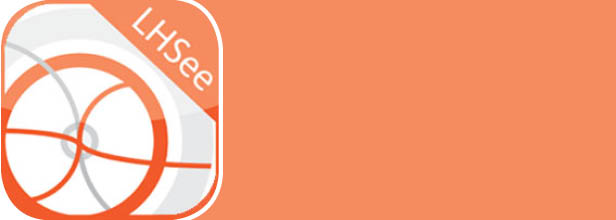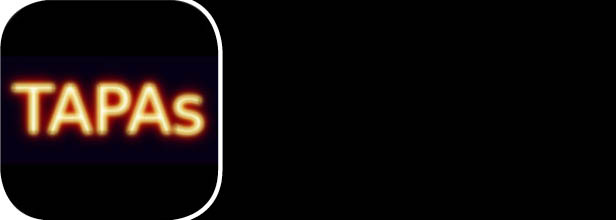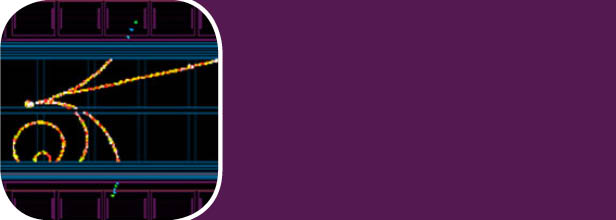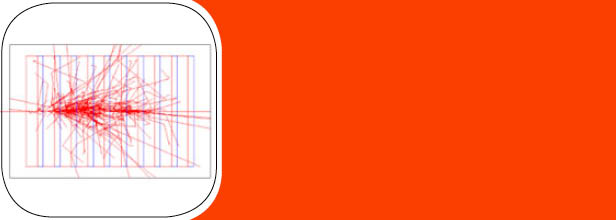From simulators and reference tools to fun and games, physics-related mobile applications run the gamut. Some of the apps were designed by physicists for use by physicists, while others are intended to inform the general public about physics laws and the field's grandest experiments, or offer an entertaining escape.
Symmetry scoured the app stores and pulled out a few of our favorites. These apps stretch the scale from massive galactic phenomena to subatomic particles, and send you on adventures ranging from Ms. Particle Man's fictional pursuit of the Higgs boson to the actual particle pathways that led to its discovery at the Large Hadron Collider.
Capturing the gravity of any situation
App name: GravLens3
Platforms: iPhone, iPad
Cost: Free
Developer: Eli Rykoff
Date launched: Summer 2009
Total downloads: Nearly 9000
Description: This free educational app allows users to simulate the effect of a large gravitational lens, such as those created by galaxies, using an iPhone or iPad camera and screen.
When Apple's App Store opened up in 2008, Eli Rykoff, then a researcher at the University of California, Santa Barbara, had just purchased a MacBook Pro. "I decided it would be fun to try to write an app," says Rykoff, who works as a research scientist on the Dark Energy Survey and Large Synoptic Survey Telescope projects for the Kavli Institute for Particle Astrophysics and Cosmology at SLAC.
He teamed with another researcher, Phil Marshall, also now at KIPAC, who supplied the math calculations, to build an educational app that quickly simulates gravitational lensing effects such as those observed in space.
In gravitational lensing, an object nearer to the observer, such as a galaxy or galaxy cluster, serves as a lens for a more distant galaxy or other object that is behind it, and the more distant object can be greatly distorted to appear as multiple images, rings or arcs. Lensing can be used to study dark matter, dark energy and the age and size of the universe.
The first version of GravLens took about six months to develop, Rykoff says, and allows users to touch their screen to move a large gravitational lens around a still image or live camera view to watch its effects.
Rykoff has continued to update the app, which has been featured in SLAC events, including a SLAC public lecture by KIPAC cosmologist Debbie Bard. This latest version, GravLens3, was released in November 2013 and allows users to wirelessly broadcast live lensing images to an external projector or screen.
Large Hadron Collider: The smartphone edition
App name: LHSee
Platform: Android
Cost: Free
Developer: Christopher Boddy, others
Date launched: October 2011
Total downloads: More than 50,000
Description: LHSee, a free app, allows you to explore the science of CERN's Large Hadron Collider and its ATLAS detector, which were instrumental in the Higgs boson discovery. You can view 3D ATLAS particle collisions data in real time and play a Higgs-search game. The app is designed for use by experts and non-experts alike.
The Large Hadron Collider at CERN is the largest experiment in the world, with thousands of collaborating scientists from around the globe. A free mobile app called LHSee helps bring its instruments and experiments closer to home for far-flung scientists and non-scientists alike.
Christopher Boddy was a graduate student at Oxford participating in the Higgs search at ATLAS, one of the main detectors at the LHC, when he started work on the app. He also spent his evenings and weekends indulging his hobby: writing smartphone games for the Android operating system.
"I loved the idea that people at home could view cutting-edge science using a device in their pocket, and had been toying with the idea," says Alan Barr, an associate professor of experimental particle physics at Oxford who oversaw the development of the apps. "The opportunity was too good to miss." Boddy built the app with support from other Oxford and ATLAS colleagues who specialized in data preparation, 3D visualizations and translating the app's scientific descriptions into different languages, including English, French, German, Italian, Spanish and Swedish.
In addition to providing background about the science of ATLAS and the LHC, the app can display experimental data for particle collisions in real time. The app also includes links to videos, particle physics information, and a game "to hunt your very own Higgs bosons."
LHSee has been downloaded more than 50,000 times, drawing more than 550 reviews and an average rating of 4.8 out of the maximum 5 stars. "One piece of rather funny feedback was from a person complaining that the app wouldn't let them actually control the LHC," Barr says.
Boddy began work on another free LHC-related app, Collider, that was completed last year by Tom McLaughlan, who also has worked in the ATLAS collaboration and at Oxford. Collider is available for Android and iPhone/iPad devices, and also features ATLAS data and games related to the Higgs boson.
Retro arcade fun on the Higgs trail
App name: Ms. Particle-Man
Platform: iPhone, iPad
Cost: 99 cents
Developer: Michael Falk
Date launched: February 2012
Total downloads: About 1000
Description: In this retro-style arcade game, you guide Ms. Particle-Man in a quest to find the Higgs boson while navigating mazes, dodging hazards and colliding with elementary particle bosses.
Motivated by a particle physics-themed variety show held in Milwaukee in 2012 that was an artful homage to scientists at Fermi National Accelerator Laboratory and others involved in the hunt for the Higgs boson, San Francisco-based computer programmer Michael Falk created a Higgs-search video game called Ms. Particle-Man.
Designed with purposely primitive graphics and addictive gameplay, "at its heart, Ms. Particle-Man is just a retro-style arcade game that uses the language of science in a light and fun way," he says. But several reviewers warn that—not unlike the real-world quest to find the Higgs boson—this game is extremely challenging.
"I was inspired by the particle accelerator work being done by scientists at Fermilab, CERN and elsewhere," Falk says, "and the idea of particles colliding felt like fertile ground for the game concept. As I read more about particle physics and quantum mechanics, what began as a simple pinball-like game morphed into a much richer game world inhabited by characters that took the form of various subatomic particles." Accelerators, photons, leptons, gluons, quarks and even dark matter play starring roles.
Falk spent more than 300 hours working on the design and programming for the game, and he is now working on Mr. Particle-Man, a "bigger and better" sequel that will include about 100 levels of play.
TAPAs: not just for dinner
App name: TAPAs Accelerator Physics
Platform: Android
Cost: Free
Developer: Michael Borland
Date launched: August 2012
Total downloads: More than 500
Description: This app provides a range of calculations related to work at synchrotrons, linear accelerators, free-electron lasers and other research facilities.
Michael Borland, an accelerator physicist, found himself making the same scientific calculations again and again. So he decided to put them together in a mobile app called TAPAs (Toolkit for Accelerator Physics on Androids) Accelerator Physics. The calculations can be applied to particle-physics accelerators as well as electron storage rings (in which electrons can circulate for hours), linear accelerators and the “guns” that give accelerated particles their initial boost, synchrotrons (which produce X-rays to study materials at the atomic and molecular level), free-electron lasers (highly tunable lasers produced by wiggling electrons in powerful magnets) and other devices.
"The greatest challenge wasn't the physics, but learning how to develop apps, given that I was only doing it my free time," says Borland, who has several other apps to his name, including APS Status, which monitors the operating status of the Advanced Photon Source at Argonne National Laboratory, and AstroLight+Calculator, a mobile tool for astronomers.
"Originally, I wrote several smaller apps that did just a few tasks each. Later, I had the idea of combining everything into one app... so it became more of a toolkit," he says.
Borland says he has used the TAPAs app on the job, including "several times during reviews, to give answers to unanticipated questions." Since its launch, Borland has added several new calculations in response to user requests or based on his own needs.
While mobile apps are a new hobby for Borland, his experience in scientific programming dates back to the 1980s. He has worked on several scientific simulation codes designed to run on machines ranging from laptops to supercomputers.
Pocket reference for particle properties
App name: Particle Properties
Platform: Android
Cost: Free
Developer: Igor Kreslo
Date launched: April 2012
Total downloads: More than 500
Description: This app features a searchable database of elementary particle properties.
Questions by students in Igor Kreslo's particle physics classes at the University of Bern in Switzerland prompted him to program Particle Properties, a mobile app that serves as a pocket reference for elementary particle properties, including particle lifetimes and how they decay.
"When looking at the event displays of some particle detectors, my students asked me, 'What are these particles? What happened there and why?'" Kreslo says. "This need was what inspired me to write this app."
He adds, "The functionality of this app is directly related to teaching students about particles and their interaction on the basis of detector data, which is a substantial part of my everyday work."
Kreslo, who also serves as deputy president of the scientific council of the Albert Einstein Center for Fundamental Physics at the University of Bern, says it took him about two weeks to create the original version of the app, which has since undergone a few updates. The next update, now in the works, will add information about neutrinos.
Radiation doses made easy
App name: Fluence
Platforms: iPhone, iPad
Cost: $4.99
Developer: Health Physics Apps LLC
Date launched: November 2012
Total downloads: About 100
Description: Calculate specific radiation dose rates for a range of photon-emitting materials.
Derek Jokisch, a health physics professor at Francis Marion University in South Carolina, wanted to give his students more exposure to the field, so he worked with them to build a set of mobile apps that are proving useful to professionals and the curious public, too.
Jokisch, who as a former computational radiation dosimetrist has experience in calculating radiation doses for medical treatments, formed a company called Health Physics Apps LLC and an agreement with his university to develop and launch the apps. The first release, iRadiation, is built largely around National Council on Radiation Protection and Measurements data that provides information on natural levels of radiation exposure in specific locations, coupled with data on radiation levels from some common medical procedures, such as CT (computed tomography) scans. That app is intended as an educational tool for the general public.
Fluence, another app that Jokisch produced with student programmers, who received course credit for their work, is a radiation-dose calculator that is designed to be a handy reference for students and professionals working in the nuclear sciences.
"You can input either a radionuclide [radioactive source] or a given photon energy, a distance away from that source, and give them their dose rate at that point," Jokisch says. An update is in the works for this app, which also allows you to calculate a radiation dose when there is some radiation shielding, such as concrete or lead.
Jokisch also worked with students to build RadRegs, an app that features searchable Nuclear Regulatory Commission regulations, and the latest release, Hot Particle, for Android devices, to calculate radiation dose information for skin contact with radioactive sources.
Each app took about nine to 10 months to create, Jokisch says. "I wasn't sure it would happen that fast. It was an intimidating experience when we first got started. To be able to bring something like that to fruition, it's a rewarding experience. It was a big moment for the students when their apps went live and they had something published." Several of the students who worked on the apps are continuing in graduate programs in nuclear engineering or medical physics, and one of the students has taken a full-time job writing apps, Jokisch says.
Honorable mention: A new way to visualize particles
App name: g4view
Platform: Android, iPhone, iPad, desktop computers
Cost: Free
Developer: Guy Barrand
Date launched: 2012
Total downloads: More than 500
Description: Based on a popular particle simulation toolkit, called Geant4, used in high-energy physics experiments, this app allows you to simulate and visualize particles produced in high-energy physics experiments, and to customize the colorful displays that represent the particles and detectors. Barrand, a software engineer working at the Linear Accelerator Laboratory (LAL) in France, has built several other high-energy physics apps, including agora, ioda and pmx, which run on a variety of mobile and desktop platforms.
Honorable mention: Your ticket to the colorful cast of The Particle Zoo
App name: Particle Zoo
Platform: iPhone, iPad
Cost: Free
Developer: Richard Burgess
Date launched: August 2009
Total downloads: More than 160,000
Description: Get to know the particles that make up our universe, from quarks to the Higgs boson. This app, based on the lineup of The Particle Zoo plush toys, provides an amusing, colorful resource for learning about subatomic particles.














